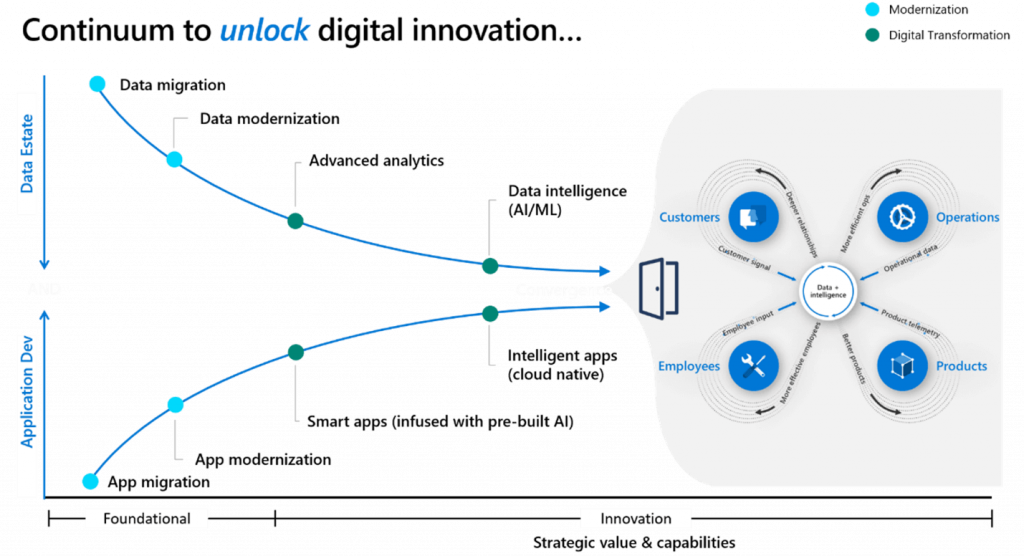Most organizations want to transform and modernize their data but don’t know where to start. After helping many organizations successfully jumpstart their data modernization journey with our BI and data solutions, we have identified key steps organizations should take to get started.
By the end of this blog, you will know how to successfully guide your organization along its data modernization journey.
Step 1: Define and Sell the Vision
To understand how to get started, you need to understand where you’re going and be pointing in the right direction. It’s important to be agile when you’re implementing a data transformation and modernization strategy because it’s going to change along the way. You also need a holistic strategy. It’s important to understand your overall business strategy and needs to be able to get started on this. So, you have to have that holistic strategy to understand what your vision is going to be.
Executive Buy-In is Critical
You need to define your vision for a data and analytics strategy at your organization. Part of that is getting buy-in from the executive level. If you’re going to transform into a data-driven organization, then there must be buy-in from the top down and the bottom up. That’s going to be a process but strive for eventual full buy-in because that’s how you will be able to fully leverage the benefits of a data-driven organization. We’re seeing a lot of organizations now leveraging a chief data officer role that’s solely responsible for how data is implemented at an organization. If your organization has such an executive role, then that’s an excellent sign you’re your organization has executive buy-in.
Organizational Buy-In is Critical
You also need to help people understand how becoming data driven is going to help them. How is their daily life going to get easier? How are they going to be able to make better decisions and improve the lives of their customers? Not everyone will immediately understand the benefits so it’s important to be patient as you drive data transformation within your organization.
It’s also important to involve business stakeholders in the decision-making process; while you want executive level support, it can’t be exclusively a top-down process. You must have buy-in from those who will be daily using your data and analytics. You need to understand what their needs truly are while you’re defining that vision. That’s going to be a continuously evolving process so you have to understand that, accept it, and embrace it. When you truly embrace that fact, then the agility that comes along with a data and analytics strategy can be really empowering.
Rethink How You Approach Data
As you’re defining your vision, you may have to rethink the way your organization approaches data. You may have to start thinking about data as a product that your organization creates and distributes to your customers, both internally and externally.
We’ve seen clients create new revenue streams by leveraging the data they already had and turning it into a new product that they can offer to their clients. We’ve also seen clients provide their data as an internal product to stakeholders and end users.
Key to thinking clearly about your data is to be honest about your current reality and map your future state. You must understand and outline your organization’s current skillsets. For example, if you’re migrating from an on-premises SQL Server-based data analytics implementation to a cloud native Azure based solution, then you will need a different skillset.
As you move from “here to there”, you will have to make some decisions. Do you upskill your current staff? Hire new staff with the necessary skillsets? Leverage a partner? You have options to get from point A to B, but success hinges on how clear you are about your current reality.
Analyze Your Current Data Assets
You must also be clear about your current data assets. To start, it will be helpful to clearly answer the following questions:
- What is your current overall data estate?
- What does it look like?
- What data assets do you have?
- What can be reused in a modern data platform?
- What do you need to start from scratch?
Step 2: Prioritize Business Outcomes
Too many organizations have disconnected strategies that can work against each other and squander opportunities. Therefore, ensure you align your analytic strategy with your overall organizational strategy by answering these two questions:
- What strategic objectives within your organization can benefit from data driven execution?
- How can you accelerate your organizational strategy by applying a data driven approach to it?
Beware of building your analytics discussion around technology or tools; such a foundation will be obsolete when just one technology is retired. Instead, focus on your organization’s business needs. Therefore, don’t start this process by saying something like, “We need a data lake”. (Those who do often end up dumping all their data into it without organizing or cleaning it, creating a data swamp. That’s worse than doing nothing at all.) When you talk about tools and technology, think about what it will give you by implementing it. What business needs will it meet?
When you’re prioritizing business outcomes, another key piece is to create a road map and ensure it’s visible to the organization. Make sure stakeholders and users see the priorities and get their input on them. That naturally ties back to our earlier points about engaging your business stakeholders in the decision-making process.
Step 3: Implement a Data Governance Strategy
Define the people, processes, and technologies that will determine how data is used and governed throughout the organization. Now, more than ever, security and compliance must be key components of a data governance strategy. There are many guidelines, rules, and regulations around how data is used and maintained, who can have access to it, and how long it needs to be kept. You need to understand what those are, what rules apply to your organization, and ensure they’re implemented and formalized in a data governance strategy.
Data Lineage
Part of that strategy is ensuring you understand the lineage of data: where it starts, how it’s transformed, where it goes, who can access it, its sensitivity, and more.
Master Data Management
Your data governance strategy must also include master data management. As your organization leverages data from a growing number of sources, it becomes increasingly important to have a single source of truth of each of the data entities you’ll be analyzing.
Data Governance Enables – not Restricts
When most people hear “data governance”, they tend to think it’s a restrictive process that’s being pushed down on them from above. Instead, this is an enabling process that will help people clearly understand what data they have access to, how they’re able to use it, and how it needs to be maintained. Data Governance is necessary to have a successful data and analytics strategy. And, as with the whole data transformation journey, data governance will be an evolving process; it’s going to change and grow over time as you build out your data analytics strategy.
Read our eBook: Power BI Governance Primer
Step 4: Engage Champions Within the Organization
For this to be successful, you must have champions throughout the organization who are encouraging the use of this strategy, this new transformation, and this new culture. The data itself will only take your organization so far. The real drivers of transformation will be the people within your organization who are using that data.
Another key change is, as you’re growing your organization and hiring new people, look for data-driven people in the hiring process. Make sure they’re familiar with data, comfortable with data, and know how to use data in their decision-making process. As you’re transforming the way you think about data and use data within your organization, it’s essential you hire people who will embrace your data initiative.
Step 5: Start with a Solid Foundation
We encourage clients to start small and build a solid foundation to grow from. That will help you avoid messy re-work. It’s too easy to say, “Let’s just throw something together to get some quick wins, and then we can change it later.” Now, some may say that’s not agile, but there’s a balance between agility, delivering business value quickly, and taking on too much technical debt. Once you build that solid foundation, you want to give access to your stakeholders so they can use it and give you feedback.
Step 6: Be Agile
In nearly every project (especially if it’s a greenfield project), if your organization is used to legacy analytics, once they start to see the insights their data can provide, they will have lots of new ideas of how they can use it to drive better decision-making. Be ready for that, embrace it, and understand that things are going to change as you go and learn.
Once you start, you should iterate, measure, and continue to improve as you go through this process. As you get regular feedback from your users, be flexible to make changes because you’ll learn as you go. We have heard many organizations say they operate with an agile framework, but they’re still not very agile. Therefore, make sure to frequently revisit agile principles, re-read your data transformation manifesto, and constantly evaluate how you’re doing with your data platform project.
Consider Your Data’s Origins
Please remember that, when you’re transforming and modernizing your data strategy, you’re not doing it in a vacuum. That data is coming from somewhere. When we modernize our clients’ data strategy, we’re often also helping them with their application portfolio because it’s generating the data that we’re leveraging with our data strategy and transformational process.
In the diagram below you can follow a step-by-step process that allows us to do more advanced things as we evolve our data analytics and application modernization and sophistication.

Data Modernization Benefits
If by now you are wondering how to sell your leadership on the benefits of transforming and modernizing your data strategy, here are five benefits you can share with them.
1. Scalability
The first benefit of moving your data warehouse into the cloud is that you get scalability – the ability to accommodate growing data demands and your exponentially growing volume of data.
2. Adaptability and Agility
Adaptability lets you adapt quickly to new requirements, but that’s difficult to do if you’re not modernizing. Agility lets you grow quickly in response to increased workloads.
3. Flexibility
Data modernization will also give you the flexibility to handle all of your unstructured data. The modern data platform will let you do things like textual or sentiment analysis through various cloud sources and machine learning. Watch our on-demand webinar: How to Build a Strong Data Foundation that Enables Machine Learning.
4. Elasticity
Elasticity translates into cost savings because you can spin up or down resources based on the work you need to do – so you’re only paying for computing power when you’re using it. That delivers a lower total cost of ownership over time. Additionally, elasticity enables faster disaster recovery because you can have a low-cost model without having your own extra datacenter.
5. Accessibility
Another data modernization benefit is the ability to democratize your data – making it available to whomever needs it. If your users don’t know where to get the data, having a modern data platform makes your data accessible so they can find it themselves (without bothering you with questions).
6. Creativity
A modern data platform enables you to innovate. We often find that when you’re picking one area to modernize, it’s usually the loudest one. But when you start to build a modern data platform, that platform becomes a data hub for you to be able to innovate across all of your business. When you think about the aspects of your business as value streams, you’re able to innovate and make decisions more effectively and efficiently (as the graphic below demonstrates).

Key Takeaways
When transforming and modernizing your data strategy, enable your teams to adopt the technology and data insights and leverage partners, best practices, and common patterns to decrease your time to market / value. Remember, it’s not about the tools and technologies. The true benefit is the business outcomes you’re enabling.
Implement data governance, security, and quality to ensure that your users trust the data. If they don’t, then even the most robust and insightful data platform is a wasted effort. Think big, start small, and learn fast. Lay a solid foundation and then iterate off of it to embrace the cloud to modernize your data platform to enable scalability, agility, and adaptability.
Ready to get started? Contact us to learn how we can help you transform and modernize your data.




